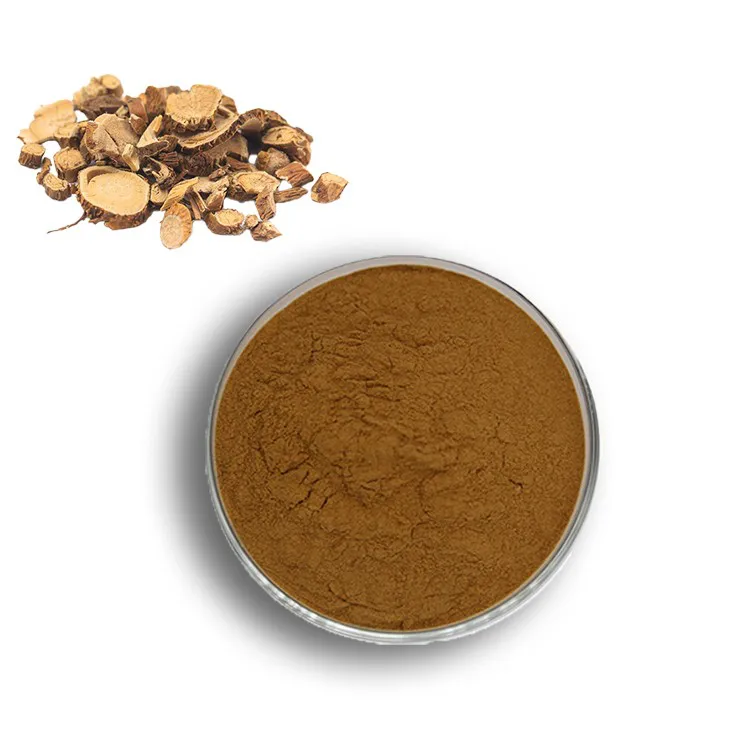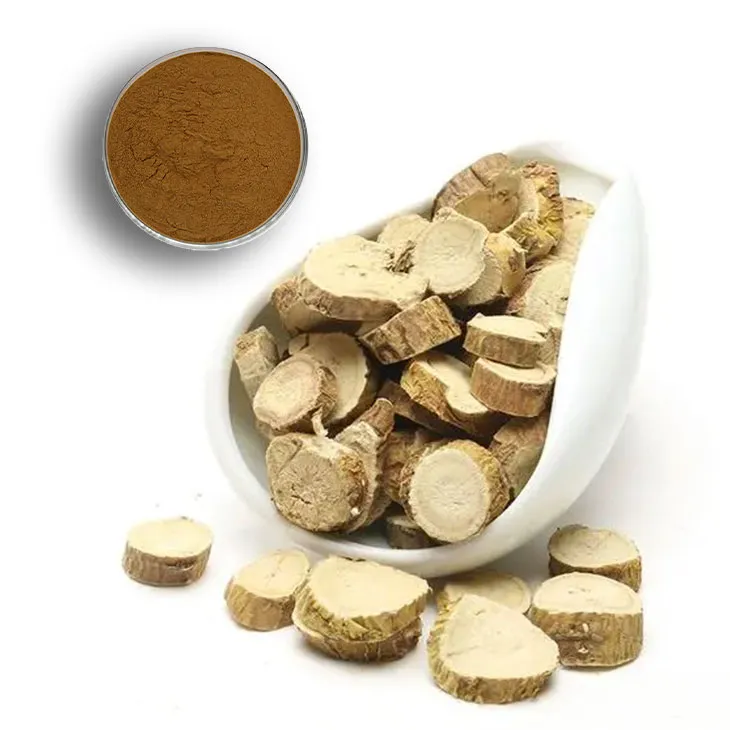- 0086-571-85302990
- sales@greenskybio.com
The process of extracting effective components from Sophora flavescens root in the Sophora flavescens root extract.
2024-11-26

1. Introduction
Sophora flavescens root is a remarkable natural resource with a wide range of potential applications in various fields such as health care and pharmacology. The extraction of effective components from Sophora Flavescens Root Extract is a complex yet highly significant scientific and technological exploration. Effective component extraction not only enables us to fully utilize the medicinal value of Sophora flavescens root but also paves the way for the development of new drugs and health - care products.

2. Sample Preparation
The first crucial step in the extraction process is the proper preparation of the Sophora flavescens root sample.
2.1 Grinding
Grinding the root into an appropriate particle size is essential. This process significantly increases the contact area with the solvent during extraction. A smaller particle size means that more surface area of the root is exposed to the solvent. For example, if the root is left in large chunks, only the outer surface of the chunks will be in contact with the solvent, limiting the extraction efficiency. However, if it is ground too finely, it may cause problems such as clogging during subsequent extraction steps. Therefore, finding the optimal particle size is a key factor in sample preparation.

3. Extraction Methods
There are several extraction methods available for obtaining the effective components from Sophora flavescens root, with traditional solvent extraction and supercritical fluid extraction being two of the most notable ones.
3.1 Traditional Solvent Extraction
Traditional solvent extraction has been widely used for a long time. In this method, a suitable solvent is selected based on the solubility properties of the target effective components. For example, ethanol is a commonly used solvent for extracting components from Sophora flavescens root due to its ability to dissolve a wide range of organic compounds. The process involves immersing the prepared root sample in the solvent and allowing sufficient time for the effective components to dissolve into the solvent. However, this method has some drawbacks. One of the main issues is that it may require a large amount of solvent, which can be costly and may also pose environmental concerns due to solvent waste.
3.2 Supercritical Fluid Extraction
Supercritical fluid extraction is a promising method in recent years. A supercritical fluid is a substance that is above its critical temperature and pressure, possessing properties between those of a gas and a liquid. For example, carbon dioxide is often used as a supercritical fluid in the extraction of Sophora flavescens root. It has the advantages of high efficiency and environmental friendliness. Supercritical carbon dioxide can penetrate into the sample more effectively, resulting in a higher extraction yield compared to traditional solvent extraction. Moreover, it is easy to remove after extraction, leaving no or very little residue, which is highly beneficial for obtaining pure effective components.

4. Refinement of the Initial Extract
After obtaining the initial extract, further refinement is necessary to purify the effective components.
4.1 Centrifugation
Centrifugation is an important step in the refinement process. It is used to remove insoluble substances from the initial extract. When the extract is centrifuged, the insoluble particles, which may include cell debris, unextracted plant material, etc., are forced to the bottom of the centrifuge tube due to the centrifugal force. The supernatant, which contains the dissolved effective components, can then be collected for further processing. This step helps to improve the purity of the extract and reduces the interference of unwanted substances in subsequent purification steps.
4.2 Crystallization and Recrystallization
Crystallization and recrystallization are effective methods for purifying the effective components. In crystallization, the extract is manipulated in such a way that the effective components form crystals. This can be achieved by adjusting factors such as temperature, concentration, and solvent composition. For example, by slowly cooling a concentrated solution of the extract, the solubility of the effective components may decrease, leading to their crystallization. Recrystallization is then carried out to further purify the crystals. The crystals obtained from the first crystallization are dissolved in a suitable solvent again, and the process of crystallization is repeated. This helps to remove any remaining impurities and results in a higher - purity product.
5. Significance of the Multi - step Process
This multi - step process of extracting effective components from Sophora flavescens root is of great significance.
- Fully tapping the potential: It enables us to fully utilize the potential of Sophora flavescens root in the fields of health care and pharmacology. The purified effective components can be used as raw materials for the development of drugs with specific therapeutic effects, such as anti - inflammatory, antibacterial, and anti - tumor drugs.
- Quality control: The multi - step process allows for better quality control of the final product. By carefully monitoring and controlling each step, from sample preparation to refinement, the purity and quality of the extracted effective components can be ensured, which is crucial for the safety and efficacy of products in the health - care and pharmaceutical industries.
- Research and development: It also provides a solid foundation for further research and development. Scientists can study the properties and functions of the purified effective components more accurately, which may lead to new discoveries and applications in the future.
6. Conclusion
In conclusion, the process of extracting effective components from Sophora flavescens root in the Sophora Flavescens Root Extract is a multi - step and complex procedure. Starting from proper sample preparation, through different extraction methods, and finally to the refinement of the initial extract, each step plays a vital role. The continuous development and improvement of this extraction process will not only help us better utilize the valuable natural resource of Sophora flavescens root but also contribute to the development of the health - care and pharmaceutical industries.
FAQ:
What are the common solvents used in traditional solvent extraction of Sophora flavescens root?
Common solvents include ethanol, methanol, and water. Ethanol is often preferred as it can dissolve a wide range of effective components while being relatively safe and easy to handle. Methanol is also effective but requires more careful handling due to its toxicity. Water can be used, especially for extracting water - soluble components, and sometimes a combination of these solvents may be employed for better extraction efficiency.
What are the main effective components in Sophora flavescens root?
The main effective components in Sophora flavescens root include alkaloids such as matrine and oxymatrine. These alkaloids have been found to possess various pharmacological activities, including anti - inflammatory, anti - microbial, and anti - tumor properties. Flavonoids are also present, which contribute to antioxidant activities.
How does supercritical fluid extraction work in the extraction of Sophora flavescens root?
Supercritical fluid extraction uses a supercritical fluid, often carbon dioxide. In the supercritical state, the fluid has properties between a gas and a liquid. It can penetrate the sample matrix easily due to its low viscosity like a gas, and has a high solvating power like a liquid. By adjusting the pressure and temperature, the solvating power of the supercritical fluid can be controlled, allowing for selective extraction of the effective components from Sophora flavescens root.
Why is centrifugation necessary in the extraction process?
Centrifugation is necessary because during the extraction process, there are often insoluble substances present in the extract. These insoluble substances can interfere with further purification steps and the quality of the final product. Centrifugation helps to separate these insoluble substances from the liquid extract by applying a centrifugal force, which causes the denser insoluble particles to sediment at the bottom, leaving a cleaner supernatant containing the effective components.
What are the challenges in the extraction of effective components from Sophora flavescens root?
One challenge is the complexity of the chemical composition of Sophora flavescens root. There are multiple types of effective components, and it is difficult to selectively extract only the desired ones without co - extracting other substances. Another challenge is ensuring the quality and stability of the extracted components. Environmental factors during extraction, such as temperature and humidity, can affect the integrity of the components. Also, regulatory compliance regarding the extraction process and the use of solvents is an important consideration.
Related literature
- Efficient Extraction of Bioactive Compounds from Sophora flavescens Root: A Review"
- "Supercritical Fluid Extraction of Alkaloids from Sophora flavescens: Optimization and Characterization"
- "Traditional and Modern Extraction Methods for Sophora flavescens Root: A Comparative Study"
- ▶ Hesperidin
- ▶ citrus bioflavonoids
- ▶ plant extract
- ▶ lycopene
- ▶ Diosmin
- ▶ Grape seed extract
- ▶ Sea buckthorn Juice Powder
- ▶ Beetroot powder
- ▶ Hops Extract
- ▶ Artichoke Extract
- ▶ Reishi mushroom extract
- ▶ Astaxanthin
- ▶ Green Tea Extract
- ▶ Curcumin Extract
- ▶ Horse Chestnut Extract
- ▶ Other Problems
- ▶ Boswellia Serrata Extract
- ▶ Resveratrol Extract
- ▶ Marigold Extract
- ▶ Grape Leaf Extract
- ▶ blog3
- ▶ blog4
-
Chinese Withania somnifera Extract Factory.
2024-11-26
-
中国松树皮提取物粉粉末供应商
2024-11-26
-
High - quality Marigold Extract Products.
2024-11-26
-
100% Pure Natural Mango - Flavored Powder.
2024-11-26
-
Saw Palmetto Extract
2024-11-26
-
Troxerutin
2024-11-26
-
Europen Bilberry Extract
2024-11-26
-
Cassia Seed Extract
2024-11-26
-
Oat Straw Extract Powder
2024-11-26
-
Lavender Extract
2024-11-26
-
Tongkat Ali Extract Powder
2024-11-26
-
Golden Seal Extract
2024-11-26
-
Sugarcane Extract
2024-11-26
-
Kupilu Extract
2024-11-26





















